 Past Projects
Past Projects
La Buona Fortuna, Michelangelo Merisi da Caravaggio c. 1594-95
 Italian Cultural Institute, New
York - May 11 - May 15, 2011
Italian Cultural Institute, New
York - May 11 - May 15, 2011
The Speed Museum, Louisville Kentucky – May 18 - June 5, 2011
Caravaggio’s Buona Ventura (The Fortune Teller) has come to us from the Capitoline Museum in Rome. While this painting depicts a small scene from everyday life, with every day people, it greatly impacted Caravaggio’s contemporaries as well as the development of Italian art. The Foundation for Italian Art and Culture (FIAC) is pleased and honored to present La Buona Ventura in New York and for the first time to audiences in Louisville, Kentucky as part of its ongoing mission to promote outstanding Italian works of art throughout the United States.
La Buona Ventura exemplifies Caravaggio’s preference for finding value and beauty in “real” people and “real” life rather than copying old masterpieces. With expert use of chiaroscuro, this quiet masterpiece shows a young woman, possibly a gypsy reading the palm of young man as she slyly removes his ring. Upon close inspection of their hands, we can see that they came from different walks of life, revealing a truth rarely seen before. It was accomplished early in Caravaggio’s career at the age of 23, and significantly marked the beginning of art as a representation of real life.
 Leonardo Da Vinci: Drawings From The Biblioteca Reale
Leonardo Da Vinci: Drawings From The Biblioteca Reale
Collection of the Biblioteca Reale, Turin, and used with permission of the Ministero per i Beni e le Attività Culturali. Photograph by Fabrizio Fenucci / Y.Press srl
Leonardo da Vinci: Drawings from the Biblioteca Reale in Turin were exhibited at the Birmingham Museum of Art in Alabama from September 28 – November 9, 2008 and at the De Young Fine Arts Museum of San Francisco November 15, 2008 – January 2009.
The works encompass one of Leonardo’s most celebrated notebooks, the Codes on the Flight of Birds, and 11 important drawings, including one described by Bernard Berenson as the “most beautiful drawing in the world.” The drawings had never before traveled as a group, nor in their entirety been made available outside of Italy. This exhibition provided a rare glimpse into the mind f the greatest draftsman of all time, whose designs still fascinate and challenge us today. Often called “the universal genius, Leonardo is recognized for his restless, inventive mind and the drawings in Turin illustrate in microcosm the extensive range of his interests.
 Antea at The Frick Collection
Antea at The Frick Collection
January 28, 2008-April 27, 2008
Letter from the President
As president of the Foundation for Italian Art & Culture( FIAC), I am delighted that the Foundation is partnering once again with The Frick Collection, this time to present one of the masterpieces of the Italian Renaissance, Parmigianino's Antea.
While the painting is recognized as one of the great portraits of the Italian Renaissance, many questions remain unanswered. For centuries, scholars have attempted to identify the woman in the portrait, but no definitive identification has ever been made. The exhibition of Parmigianino's Antea at The Frick Collection will offer audieneces an unprecedented opportunity to experience the beguiling painting and the mystery surrounding it.
FIAC's deepest gratitude goes to Professor Nicola Spinosa, Superintendent of the Museums of Naples, for the generosity lending this masterpiece to The Frick Collection, as well as to Ambassador Daniele Bodini, Chairman of FIAC, and the Alexander Bodini Foundation for making this exhibition possible.
FIAC is at the forefront of introducing American audiences to the greatest works of Italian art and culture with tremendous success. The Frick Collection has taken a special interest in FIAC's projects and we offer our sincere appreciation to Director Anne L. Poulet, Peter J. Sharp, Chief Curator Colin B. Bailey, and Christina Neilson, Andrew W. Mellon Curatorial Fellow, for their commitment and expertise.
The exhibit of Parmigianino's Antea is another example of The Frick Collection's and FIAC's dedication to making timeless works of art accessible to the larger public.
Alain Elkann
President, Foundation for Italian Art and Culture
Senso Unico at P.S.1 MoMA
October 21, 2007 – January 7, 2008
P.S.1. Contemporary Art Center presented Senso Unico, a selection of Italian Artists who have maintained a prominent presence in the international contemporary art world over the past decade. Senso Unico took an intimate look at the work of eight influential figures: Vanessa Beecroft, Paolo Canevari, Angelo Filomeno, Ra di Martino, Adrian Paci, Paolo Pivi, Pietro Roccasalva and Francesco Vezzoli.
Federico Da Montefeltro And His Library at the Morgan Library
June, 2007 – September 2007
One of the most astonishing libraries of the Italian Renaissance was the subject of an exhibition at the Morgan Library: the Library of Federico da Montefeltro. Federico helped to transform Urbino, a small Renaissance state, into a bustling cultural and economic center. His home became the meeting place for many architects, painters and writer.
The exhibition was on display in the Morgan's Clare Eddy Thaw Gallery in a space which was a recreation of Montefeltro's Studiolo. The centerpiece of the exhibition was the famous portrait of the fully armoured Federico reading in his ducal library to his son Guidobaldo, at his side. The show also included the imposing eagle shaped lectern from the Museo Diocesano Albani in Urbino, a group of lavishly illuminated manuscripts and an incunable.
On Saturday, June 9, 2007 at 2pm the Morgan Library presented a half-day symposium called The Montefeltro Library and The Urbino Renaissance which provided an overview of the exhibit and lectures by distinguished scholars on Piero della Francesca, Raphael, and Castiglione. This event was cosponsored by the Italian Cultural Institute.
 Grinzane Masters
Grinzane Masters
April 2007
On Tuesday, April 17, 2007 author Philip Roth received the first Grinzane Masters award in recognition of his excellence as a writer and for introducing the work of Primo Levi to American readers. He was awarded $25,000 in the memory of the Italian Jewish writer, chemist, Primo Levi on the anniversary of his death. FIAC was delighted to take part in this auspicious occasion. The event was hosted by the Italian Academy for Advanced Studies at Columbia University and sponsored by the Compagnia di San Paolo.
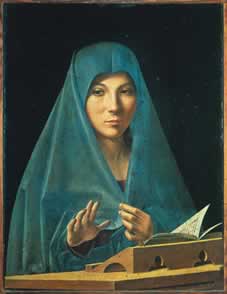 Antonello da Messina (Antonello di Giovanni d'Antonio), Italian, Sicilian, born about 1430, died 1479
Antonello da Messina (Antonello di Giovanni d'Antonio), Italian, Sicilian, born about 1430, died 1479
December, 2005 – February 2006
Antonello da Messina is considered one of the greatest Renaissance painters namely for his development of character and psychology in portraiture. From his native city of Messina in Sicily, the master traveled the commercial and artistic routes of Italy and perhaps even those of Northern Europe. On his way, he absorbed the new developments in painting of the time and translated them into his own unique and personal style.
In Naples, he encountered the Flemish style, in Rome and Florence he was influenced by the developing Renaissance techniques - especially those by Piero della Francesca - and, during a prolonged working period in Venice, he contributed extensively to the birth of the Venetian school.
It is not surprising that a Sicilian painter would synthesize such a variety of influences in his artworks. During Antonello's time, Sicily was a truly cosmopolitan island as it had been for centuries at the crossroads of civilizations. Sicilian artists and intellectuals looked towards foreign influences with a worldly attitude interested only in acquiring the best of them.
Antonello is most notably recognized for revolutionizing the style of portraiture. In a sense, he was the first modern portrait painter. He combined great attention to detail and precision with psychological insight. Before Antonello, Italian portraits only depicted the frontal or side view of an individual. Antonello created the three-quarter portrait that shows more of a subject's face and allows greater insight in their personality. Although this style is generally attributed to Leonardo da Vinci, it was invented by Antonello. The famous Portrait of Unknown Man, from the Mandralisca museum in the small and beautiful Sicilian town of Cefalu’, depicts a man described as “typically Sicilian,” with his “ammiccante” (devious, snitching, betraying) gaze. A leading scholar of Italian painting, Federico Zeri, wrote that the Unknown Man represents and universalizes the wily, devious, scheming and yet clever intelligent, nature of the Sicilian and Mediterrenean male.
Another major painting by Antonello which has remained in Sicily is the Annunciate Madonna from the Palazzo Abatellis Museum in Palermo. As one of his most famous paintings, it is religious in subject and provides a graceful combination of both Italian and Northern European influences.
In December 2005, FIAC sponsored an exhibition of these two works at the Metropolitan Museum of Art in New York. The exhibition provided a unique opportunity to view the two splendid works alongside another of Antonello's exquisite paintings Christ crowned with Thorns which is part of the Metropolitan Museum of Art's Permanent Collection. While working on this project, FIAC was pleased to learn that Antonello da Messina is the favorite painter of Dr. Philip de Montebello, the director of the Metropolitan Museum of Art. In March 2006, a major exhibition of Antonello, with loans from all over the world, was held at the Scuderie del Quirinale in Rome.
Countless participants allowed for the organization of this exhibition. FIAC would like to extend special thanks to the On. Alessandro Pagano, Assessore Regionale ai Beni Culturali, Ambientali e alla Publica Istruzione.
Orsanmichele
September 2005 – December 2005
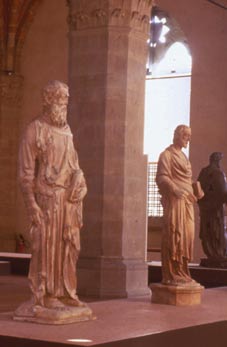 In 1984 the Opificio
delle Pietre Dure began to restore all the marble
and bronze sculptures in the fourteen niches on the outside
of the church of Orsanmichele in Florence; with this
year’s restoration of Lorenzo Ghiberti’s bronze statue of Saint Matthew, the project is drawing to a close. Three of the newly restored statues by Verrocchio, Lorenzo Ghiberti and Nanni di Banco will soon travel to the United States and be exhibited at the National
Gallery of Art.
In 1984 the Opificio
delle Pietre Dure began to restore all the marble
and bronze sculptures in the fourteen niches on the outside
of the church of Orsanmichele in Florence; with this
year’s restoration of Lorenzo Ghiberti’s bronze statue of Saint Matthew, the project is drawing to a close. Three of the newly restored statues by Verrocchio, Lorenzo Ghiberti and Nanni di Banco will soon travel to the United States and be exhibited at the National
Gallery of Art.
A former grain market, Orsanmichele became a church in the fourteenth century, while preserving its civic vocation by becoming the religious center of the Arts [le Arti], the powerful crafts guilds which played a prominent role in the city’s politics and economy. Indeed, from the outside Orsanmichele looks more like a palazzo than a church. On the walls of its tall, crenellated, block like form are fourteen marble niches, originally assigned, starting in the Trecento, to house the patron saints of the various Arti. Facing outward, towards the city, and not half-hidden in shadows of a church interior, the effigies were supposed be a kind of public declaration of their devotion as well as the prestige of the Arti’s patronage – at the time, in Florence, power and wealth were expressed through art (o tempora, o mores…). This explains, therefore, how the extraordinary new path taken by Florentine sculpture in the Quattrocento led to the replacement of the “outdated” Gothic statues in the church’s niches with the humanized divinities carved by Donatello, Nanni di Banco, Ghiberti, and Verrocchio.
An exceptional “open air” museum of Renaissance statuary was thus created, as precious as it is vulnerable, given the increasingly noxious environmental conditions that have emerged in the last half century. A confirmation of this latter problem can be found by comparing photos of Donatello’s marble Saint Mark taken in the 1920s, when the statue was still nearly intact, with photos taken fifty years later, which show erosion from acid rain in the face and drapery. For this reason, in the 1980s the Opificio launched a program of overall review of the sculptural complex of Orsanmichele, beginning the restoration with none other than the Saint Mark, the most endangered of the statues, and supplementing their preliminary diagnostic inquiries with documentary research on the sculptural cycle’s history. Cross-referencing the findings gathered in the two areas of research has made it possible to ascertain that the marble statues’ particularly darkened surfaces were due not only to atmospheric deposits but also to an artificial patinating treatment of linseed oil pigmented with mineral soils [terre minerali], applied sometime around the late eighteenth or early nineteenth centuries.
In all likelihood this intentional modification of the statues’ appearance corresponded to demands of conservation as well as taste. The oil is a water-repellent that was often used in the past to waterproof and protect stone, and the artificial “bronzing” effect that the treatment gives to the marble sculptures made them fit in better with the bronzes with which they alternated in the niches, in keeping with a widespread preference in the eighteenth and nineteenth centuries for artificially “ageing” the surfaces of stone works and even paintings.
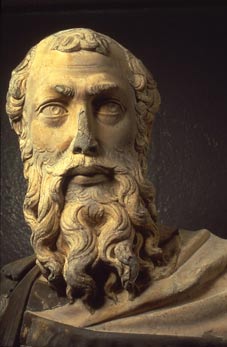 Once the nature and chronology of the treatment was verified for the Saint Mark as well as the other marbles later slated for restoration, it was decided to remove the patination, which betrayed the artists’ original intentions, obscuring, among other things, the remnants of the gilding, applied with gold leaf and glue, which once lit up the white shapes of the patron saints of the Arts with luminous glimmers. The severe solemnity of the Saint Mark’s forms was tempered with gold in the saint’s hair and flowing beard, as well as in his clothing’s embroidery and on the stud in the middle of the binding of the Gospel he is holding on the right. On the other side, Nanni di Banco’s gigantic Saint
Philip once displayed its beardless face under a head of blond hair while a golden thread extended down his ample gown, highlighting its pleated edge. In the niche beside it, the four figures of the Santissimi Coronati, also by Nanni, have gold embroidery on their gowns, even over certain chisel-marks made to fit the statues inside the niches, a detail that has led one to believe that the gilding was applied after the statues were already in place, probably to heighten the effect of the overall view.
Once the nature and chronology of the treatment was verified for the Saint Mark as well as the other marbles later slated for restoration, it was decided to remove the patination, which betrayed the artists’ original intentions, obscuring, among other things, the remnants of the gilding, applied with gold leaf and glue, which once lit up the white shapes of the patron saints of the Arts with luminous glimmers. The severe solemnity of the Saint Mark’s forms was tempered with gold in the saint’s hair and flowing beard, as well as in his clothing’s embroidery and on the stud in the middle of the binding of the Gospel he is holding on the right. On the other side, Nanni di Banco’s gigantic Saint
Philip once displayed its beardless face under a head of blond hair while a golden thread extended down his ample gown, highlighting its pleated edge. In the niche beside it, the four figures of the Santissimi Coronati, also by Nanni, have gold embroidery on their gowns, even over certain chisel-marks made to fit the statues inside the niches, a detail that has led one to believe that the gilding was applied after the statues were already in place, probably to heighten the effect of the overall view.
Only rare and precious fragments of this ancient sparkle remain today, made more legible by the latest restorations, which use a new laser technology that in cleaning can separate the deposits and patination from the underlying traces of gold. In being cleaned, the bronzes of Orsanmichele – whose constituent material is in a better state of conservation than the marble – have also recovered the softness and luminosity of the original metal forms, which likewise show traces of lacquer gilding. In the case of the three statues by Ghiberti, who rediscovered the art of monumental bronze casting, under the deposits that once hid it we can now see silver leaf inlaid into the bronze to suggest the corneas of the eyes, as in the sublime Greek statues of gods and heroes.
The Humanistic heroes appointed to protect the Arts in Florence could risk further damage from defenseless exposure to air pollution. The Opificio, along with various Florentine Soprintendenze, thus opted to place them within museums after their restoration, as a cautionary measure subject to reversal. Furthermore it was decided the originals would be replaced with copies which will preserve, in the original setting, an image and memory of the sculptures that have been an integral part of the city’s historic centre for over half a millennium.
The removal of the originals from their intended setting was made partly less traumatic by the decision to keep them at Orsanmichele, in the great hall on the floor above the church, which has been turned into a Museum for the statues formerly in the niches. Soon, when the Saint Matthew returns, the cycle will be complete again and visible in the renovated Museum, in whose vast space the statues lose none of their physical and psychological monumentality, offering themselves to our eyes in their entirety, as though they were still in the artists’ studios, awaiting to be placed in their setting. Let us hope that at some future time, wiser and more advanced than our own, they can be returned there.
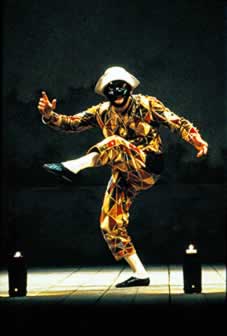 Arlecchino Servitore Di Due Padroni
Arlecchino Servitore Di Due Padroni
July 2005 – October 2005
The Foundation will partiticipate in the sponsorship of a US tour by the Piccolo Teatro di Milano, the leading Italian theatrical company. The company will be performing Arlecchino Servitore di Due Padroni (Arlecchino Servant of Two Masters) by Carlo Goldoni. The play, directed by the late Giorgio Strehler, has performed worlwide for over fifty years to critical acclaim. Virtuoso actor Ferruccio Soleri, who is in his mid-seventies and continues to display the agility and acrobatic dexterity typical of performers in the Commedia dell'Arte tradition, will play the leading role. The US tour will start at the Lincoln Center Festival in New York in July 2005, and will continue to the following cities: Colorado Springs, Los Angeles, Berkeley, California, Ann Harbor, Michigan, Minneapolis and Chicago.
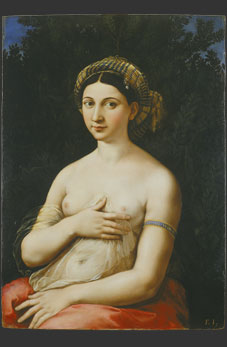 La Fornarina
La Fornarina
December 2004 – January 2005
“La Fornarina,” also known as “La Fornarina Barberini” after the name of the family who acquired it from the Boncompagni around 1642, is recognized as one of Raphael’s greatest masterpieces, as well as one of the major works of the Italian Cinquecento. Painted around 1520, the year of Raphael’s death, the Fornarina depicts a woman who is believed to have inspired other female figures in the artist’s major works, and most notably the “Velata” in the Pitti Gallery in Florence. Although the identification remains uncertain, she is believed to represent the painter’s lover, Margherita Luti, the daughter of a Sienese baker who lived in Rome, hence the name “Fornarina,” from “forno” (oven).
During the nineteenth century the Romantic myth of the muse-lover developed around the painting. According to the sculptor Antonio Canova, who recognized the same character of La Fornarina in Raphael’s frescos in the Stanza di Eliodoro in the Vatican, “she is the most beautiful figure made by Raphael of his loved one” (quoted by Missirini in 1828).
Despite its apparent simplicity, the symbolism is rather complex. X-rays made during the restoration conducted in 2000 and sponsored by Estée Lauder and the Lekythos perfume company, revealed a landscape behind the figure, which Raphael subsequently covered and substituted with branches of myrtle and quince, plants sacred to the Greek goddess Venus and symbols of erotic desire. Post-restoration consensus denies the traditional opinion that Raphael’s pupil Giulio Romano also worked on the painting. The size of the painting, in metrical measurements, is cm 85.5 by 61.5.
Splendor Of Florence
9/30/04 - 10/12/04
Splendor is an eleven-day festival of cultural, educational, culinary, and musical events centered around distinguished Florentine artisans. More >>